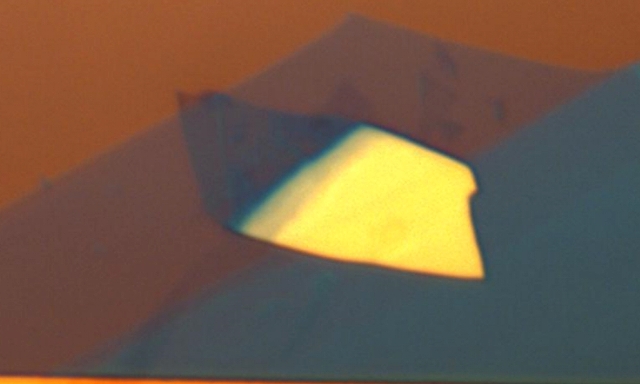University of Rochester researchers have generated light-emitting quantum dots using defects in an atomically thin semiconductor. The quantum dots initiate the production of single photons and are capable of combining quantum photonics and solid-state electronics, which is collectively called as integrated photonics.
 Optical micrograph of electrically contacted tungsten diselenide. This atomically thin semiconductor is the host of an new type of quantum dot that exhibits voltage controlled single photon emission. (Image courtesy of Chakraborty et al.)
Optical micrograph of electrically contacted tungsten diselenide. This atomically thin semiconductor is the host of an new type of quantum dot that exhibits voltage controlled single photon emission. (Image courtesy of Chakraborty et al.)
Scientists are now showing interest in integrated solid-state devices for applications that involve quantum information processing. However, they claim that it is difficult to identify a basic mechanism on the interaction of quantum dots in atomically thin semiconductors, and hence their application in nanophotonics remains a challenge.
Quantum dots, often known as artificial atoms, are naturally occurring or artificially induced defects in solids that serve as a key area of interest for various research applications. Nick Vamivakas, senior author on the paper and assistant professor of optics at the University of Rochester stated that the scientists are also focusing on other 2D, atomically thin materials like graphene for optoelectronics applications. However, optically active quantum dots have not yet been observed in these 2D materials.
In this study, the researchers have developed an atomically thin semiconductor using tungsten diselenide (WSe2) that could potentially result in solid-state quantum dots. However, the electrical or optical performance of the semiconductor was not affected by the defects that produce quantum dots. With the application of electric and magnetic fields, these defects can be tweaked.
Vamivakas described that the voltage application can regulate the brightness of the quantum dot emission. He added that tuning the color of the emitted photons using voltage is the next step of their experiment, which could lead to the incorporation of these dots into nanophotonic devices.
The method for producing quantum dots in atomically thin tungsten diselenide is easier when compared to the method that employs conventional materials such as indium arsenide.
We start with a black crystal and then we peel layers of it off until we have an extremely thin later left, an atomically thin sheet of tungsten diselenide,
Vamivakas.
The point of overlap of two sheets induces a defect in the smooth 2D semiconductor material sheet, and as a result a quantum dot is produced. These thin semiconductor sheets are convenient for integration with other electronics.
One of the desirable features possessed by the quantum dots in tungsten diselenide sheets is the electron spin, an intrinsic quantum degree of freedom. The spin can hold quantum information and serve as a probe to explore local quantum dot environment.
What makes tungsten diselenide extremely versatile is that the color of the single photons emitted by the quantum dots is correlated with the quantum dot spin. He also added that the applications of these systems on nanoscale metrology and quantum information are dependant on the ease of interaction between the spins and photons.
Chitraleema Chakraborty
The study results were published in the Nature Nanotechnology journal.
References